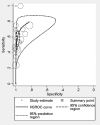PCR using blood for diagnosis of invasive pneumococcal disease: systematic review and meta-analysis
- PMID: 20007385
- PMCID: PMC2815606
- DOI: 10.1128/JCM.01636-09
PCR using blood for diagnosis of invasive pneumococcal disease: systematic review and meta-analysis
Abstract
The use of molecular-based methods for the diagnosis of bacterial infections in blood is appealing, but they have not yet passed the threshold for clinical practice. A systematic review of prospective and case-control studies assessing the diagnostic utility of PCR directly with blood samples for the diagnosis of invasive pneumococcal disease (IPD) was performed. A broad search was conducted to identify published and unpublished studies. Two reviewers independently extracted the data. Summary estimates for sensitivity and specificity with 95% confidence intervals (CIs) were calculated by using the hierarchical summary receiver operating characteristic method. The effects of sample processing, PCR type, the gene-specific primer, study design, the participants' age, and the source of infection on the diagnostic odds ratios were assessed through meta-regression. Twenty-nine studies published between 1993 and 2009 were included. By using pneumococcal bacteremia for case definition and healthy people or patients with bacteremia caused by other bacteria as controls (22 studies), the summary estimates for sensitivity and specificity were 57.1% (95% CI, 45.7 to 67.8%) and 98.6% (95% CI, 96.4 to 99.5%), respectively. When the controls were patients suspected of having IPD without pneumococcal bacteremia (26 studies), the respective values were 66.4% (95% CI, 55.9 to 75.6%) and 87.8% (95% CI, 79.5 to 93.1%). With lower degrees of proof for IPD (any culture or serology result and the clinical impression), the sensitivity of PCR decreased and the specificity increased. All analyses were highly heterogeneous. The use of nested PCR and being a child were associated with low specificity, while the use of a cohort study design was associated with a low sensitivity. The lack of an appropriate reference standard might have caused underestimation of the performance of the PCR. Currently available methods for PCR with blood samples for the diagnosis of IPD lack the sensitivity and specificity necessary for clinical practice.
Figures




References
-
- Abdeldaim, G., B. Herrmann, P. Molling, H. Holmberg, J. Blomberg, P. Olcen, and K. Stralin. 14 October 2009. Usefulness of real-time PCR for lytA, ply, and Spn9802, applied to plasma samples to detect pneumococcal pneumonia. Clin. Microbiol. Infect. [Epub ahead of print.] - PubMed
-
- Abdeldaim, G. M., K. Stralin, P. Olcen, J. Blomberg, and B. Herrmann. 2008. Toward a quantitative DNA-based definition of pneumococcal pneumonia: a comparison of Streptococcus pneumoniae target genes, with special reference to the Spn9802 fragment. Diagn. Microbiol. Infect. Dis. 60:143-150. - PubMed
-
- Afshar, N., J. Tabas, K. Afshar, and R. Silbergleit. 2009. Blood cultures for community-acquired pneumonia: are they worthy of two quality measures? A systematic review. J. Hosp. Med. 4:112-123. - PubMed
-
- Anh, D. D., P. E. Kilgore, M. P. Slack, B. Nyambat, H. Tho le, L. M. Yoshida, H. A. Nguyen, C. D. Nguyen, C. Y. Chong, D. Nguyen, K. Ariyoshi, J. D. Clemens, and L. Jodar. 2009. Surveillance of pneumococcal-associated disease among hospitalized children in Khanh Hoa Province, Vietnam. Clin. Infect. Dis. 48(Suppl. 2):S57-S64. - PubMed
-
- Azzari, C., M. Moriondo, G. Indolfi, C. Massai, L. Becciolini, M. de Martino, and M. Resti. 2008. Molecular detection methods and serotyping performed directly on clinical samples improve diagnostic sensitivity and reveal increased incidence of invasive disease by Streptococcus pneumoniae in Italian children. J. Med. Microbiol. 57:1205-1212. - PMC - PubMed
Publication types
MeSH terms
Substances
LinkOut - more resources
Full Text Sources
Medical

